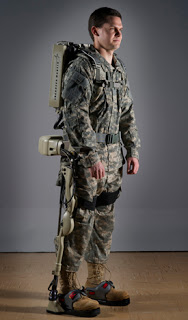 Biomechanical testing of the Lockheed Martin [NYSE: LMT] ruggedized HULCTM exoskeleton is now underway at the U.S. Army Natick Soldier Research, Development and Engineering Center in Natick, Mass. The testing is expected to help shape future requirements for the HULC based on feedback from soldiers.
Biomechanical testing of the Lockheed Martin [NYSE: LMT] ruggedized HULCTM exoskeleton is now underway at the U.S. Army Natick Soldier Research, Development and Engineering Center in Natick, Mass. The testing is expected to help shape future requirements for the HULC based on feedback from soldiers.
For seven weeks, U.S. Army warfighters will be evaluated to assess the effects of load carriage with and without use of the HULC exoskeleton. Biomechanical testing will measure changes in energy expended by users, assessing how quickly individuals acclimate to the system and whether there is a reduction in metabolic cost. Testing will also determine if there is an improvement in metabolic efficiency as measured by oxygen consumption per unit total mass, when wearing the ruggedized HULC as compared to not wearing the device under identical load, speed, grade and duration conditions.
Lockheed Martin’s HULC is an un-tethered, battery powered, hydraulic-actuated anthropomorphic exoskeleton that provides users the ability to carry loads up to 200 pounds for up to 20 kilometers on a single battery charge over all terrains. HULC’s design allows for deep squats, crawls and upper-body lifting with minimal human exertion. An advanced onboard micro-computer ensures the exoskeleton moves in concert with the operator. HULC is an innovative solution that improves endurance and reduces the risk of injury to the soldier.
“Our latest generation of the HULC design provides unmatched flexibility, strength and endurance,” said Jim Ni, HULC program manager at Lockheed Martin Missiles and Fire Control. “It will enable soldiers to do things they cannot do today, while helping to protect them from musculoskeletal injuries.”
The Department of Veterans Affairs reports that the most prevalent service-connected disabilities stem from musculoskeletal system injuries.
Following successful biomechanical evaluations, the ruggedized HULC system will transition to a series of field excursions to measure its utility in simulated operational environments.
If you liked this article, please give it a quick review on ycombinator or StumbleUpon. Thanks

Brian Wang is a Futurist Thought Leader and a popular Science blogger with 1 million readers per month. His blog Nextbigfuture.com is ranked #1 Science News Blog. It covers many disruptive technology and trends including Space, Robotics, Artificial Intelligence, Medicine, Anti-aging Biotechnology, and Nanotechnology.
Known for identifying cutting edge technologies, he is currently a Co-Founder of a startup and fundraiser for high potential early-stage companies. He is the Head of Research for Allocations for deep technology investments and an Angel Investor at Space Angels.
A frequent speaker at corporations, he has been a TEDx speaker, a Singularity University speaker and guest at numerous interviews for radio and podcasts. He is open to public speaking and advising engagements.

